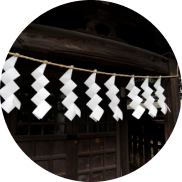Shide
The white zigzag papers often hang from the shimenawa mentioned above. These items are often used to demarcate the boundaries of a sacred space or border within the sanctuary. The lightning-shaped decorations are called “shide” (pronounced “she-day”) and are also used in a variety of purification ceremonies.
There are two theories behind why the shide has its ray shape. One claims that the shape is representative of the infinite power of the gods, and another suggests that, as rain, clouds and lightning are elements of a good harvest, the lightning-shaped shadow is a prayer to the gods for a bountiful season.
There are a variety of different shide-adorned wands used in Shinto, with subtle differences between them in terms of style. Two of these wands are called “gohei” and “haraegushi.” Priestesses called “miko” use the gohei wand with two shide attached in rituals and ceremonies to bless people, but the main purpose of the wand is to bless objects or purify sacred objects.
The haraegushi wand with many shields attached is used for the same cleaning purpose, but under different circumstances. A Shinto priest rhythmically waves the haraegushi over a person or objects recently obtained by a person, such as a new house or car, to perform this purification ritual.


